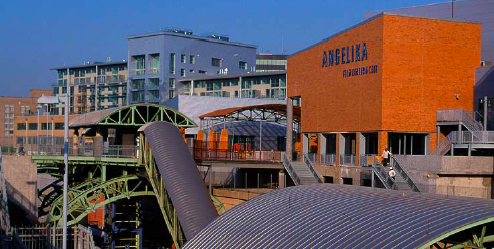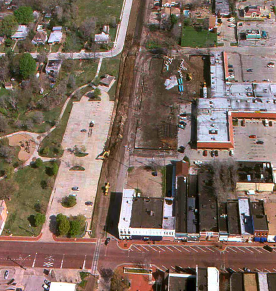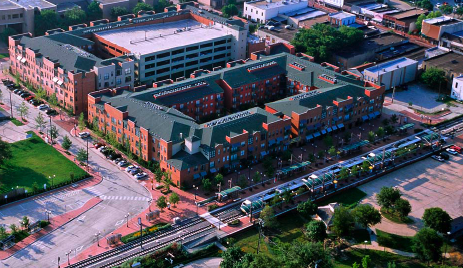For decades, Dallas mega-suburb Plano planned and prepared for this moment.
The historic downtown -- a poorly-scaled anachronism from when this city of 260,000 housed a mere 3,500 people -- was revitalized and reimagined as a "transit village." Tax increment financing helped support urban-style, walkable development.
All because DART was building a rail line and forward-thinking town leaders wanted to be ready. Now decades of careful planning and preparation are paying off; Plano is poised to secure $60 million in transit oriented development near its two rail stations.
After an earlier deal was thwarted by the economic downturn in 2008, Tennessee-based developer Southern Land Co. announced intentions recently to break ground on a $30 million, 280-unit mixed-use apartment complex in downtown Plano this spring. Meanwhile, the city is negotiating with local developer Prescott Realty Group for a project of a similar scale one stop down the Red Line at the Parker Road station, the Dallas Morning News reports.
Last week the paper lamented that the recession has hampered the (perhaps overly optimistic?) fortunes that were anticipated when DART began building what is today the country's largest light rail system. But as the real estate shock thaws (at least in Texas), Plano is one of several Dallas area communities that are cashing in on DART's expansion.
The new rail stations have raised property values along Plano's rail corridor about 200 percent, said Deputy City Director Frank Turner. That has generated about $40 million from Tax Increment Financing, a method for taxing projected increases in property values. That money will be used to help advance its vision for a vibrant, walkable downtown, a pattern the city hopes to repeat at the further flung Parker Road station as well.
Patrick Kennedy (Streetsblog Network writer from Walkable Dallas Fort Worth) remarked on the suburb's success in a recent article for D Magazine:
I visited downtown Plano last year. Even in the recession, the thwack-thwack-thwack of hammers filled the air with the optimism of new construction. I counted eight storefront renovations or new construction projects.
That was the vision for downtown Plano that began taking shape back in 1983 when Dallas Area Rapid Transit (DART) was formed and Plano was one of the first communities to "opt in," setting aside a one-cent property tax to support the transit service.
Since that time, the community has invested about $1 billion -- or roughly $50 million a year -- in the public transportation system, city officials say. That includes comprehensive bus and paratransit service as well as light rail.
In the late 1990s, when Plano learned it would become a stop on DART's light rail line, City Council decided its historic downtown should become a "transit village." The neighborhood should be walkable, dense, with a mix of land uses. It should have the kind of amenities that would appeal to tenants that are looking for a more urban lifestyle. The city's plan called for 1,000 new housing units near the station downtown.
All this was done to set the stage for high-density transit oriented development. After all, you can't just build hundreds of apartments next to transit and expect it to become an attractive, urban community, says Turner.
"Transit gives you an edge but that’s not sufficient," he said. "You really have to have the urban amenities, the lifestyle things in order to command the premium in rent."
The newest development in downtown Plano will include a minimum of 280 residential units on about 3 acres. Parking minimums are about 20 percent lower than elsewhere in the city.

Plano is using Tax Increment Financing money to subsidize the downtown development with $1.7 million -- with the requirement that it be used only to develop public amenities, including park space, a police substation and parking spaces for the police department.
And although, as the Dallas Morning News noted, some of the Dallas region's TOD dreams have been delayed by the real estate market, Plano is certainly not the only bright spot in the Dallas TOD market.
Despite its reputation for being a car-centric city, Reconnecting America [PDF] says the Dallas region is the country's 10th best market for transit oriented development.
DART's Office of Economic Development says that as early as 1999, the light rail system had increased station adjacent property values by 25 percent. By 2005, the total value of development by stations had added up to $3.3 billion. And by 2007, local communities had collected an additional $78 million in tax revenues due to property value increases.
There are other good examples in the region. DART points to the Mockingbird Station in Northeast Dallas, Cedars Station near the city center, and Irving's Texas Station redevelopment project, to name a few.
The moral of the story, seems to be that investment in transit and smart growth is paying off -- for communities that were forward-looking enough to plan ahead.
Currently, Plano is competing with the suburb of Richardson for a stop on the upcoming Cotton Belt Rail Line. In the D Magazine article quoted above, Kennedy makes his point that Plano is the deserving community.
"Sorry, Richardson," he wrote. "Your neighbor to the north has a downtown worth supporting."







